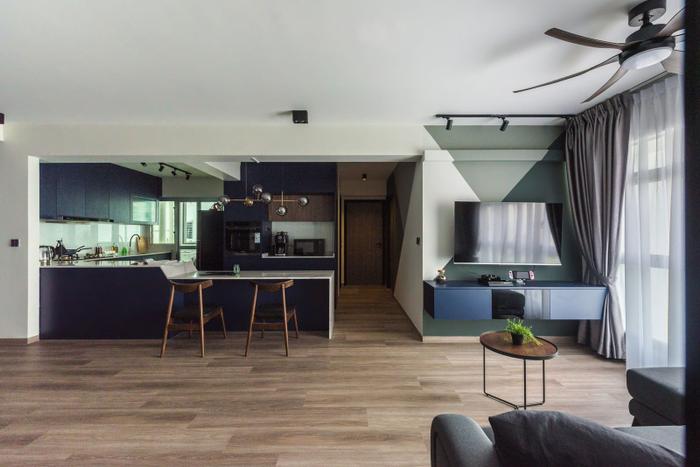We’ve done the groundwork and rounded up some of Singapore’s most-loved flooring options. Question is, which is the right pick for your home?
As one of the largest surfaces in the home, the floor is integral when it comes to interior design – it’s often the first point of physical contact PLUS acts as a canvas on which you build your home.

View this project by Jialux Interior
That said, there are many flooring options available – each with its own distinct look and edge – so where do you even begin to look? Well, everything you need to know is right here! Scroll on to discover the pros (and cons) of the most popular flooring types in Singapore.
1. Vinyl
Waterproof, resilient, available in a wide range of “styles” (tiles, sheets, planks etc.) and affordable: it’s hard to find an alternative that’s as good as vinyl. However, it’s far from being the eco-friendliest option on the market.

View this project by PULP Design Studio
See, vinyl flooring is mainly made out of PVC, which is harmful to the environment as it produces toxic substances when burned. The good news is that there’s a less damaging alternative for those wanting to replicate the look of natural wood: High End Resilient Flooring (HERF).

View this project by SG Interior KJ
Manufactured from virgin pulp, HERF does not contain the more poisonous chemical, phthalates, that increases the flexibility and lifespan of plastics (i.e. those found in your typical vinyl options).

View this project by Apartment
| Pros | Cons |
|
|
2. Cement Screed
Cement screed is a common sight in most industrial-style homes. Made from a mixture of sand and cement, the floor has a grey hue that adds on to the masculine charms of such abodes.

View this project by Flo Design
Because of its nature, it can appear smooth or textured (with a non-slip sealer), but most importantly, it’s seamless. However, it does require additional care and maintenance to keep it looking that way.
As it’s porous in nature, cement floors can stain really easily. It’s a must to keep them completely sealed. Even then, it’s not advisable to use cement in more moisture-prone areas like bathrooms or outdoor balconies as sealers are not wear-proof.

View this project by Insight.Out Studio
If you aren’t caring for these floors the proper way, you might see hairline cracks appearing; when there’s moisture loss from evaporation, the hardened layers of cement contract and fractures crop up across the surface.

View this project by Authors • Interior & Styling
| Pros | Cons |
|
|
3. Tiles
Can be made of either ceramic or porcelain. They come in a variety of designs and finishes, including the HDB-approved homogeneous tiles (which are just porcelain tiles without a glass layer or decorative finish).

View this project by Cozy Ideas
In general, tiles can be used in high-traffic and moist areas in the home. Strong and non-porous, the tile is resistant to liquids, making it harder to stain than its counterparts.

View this project by Jesigns Interior Design
Despite how hard-wearing it is, the grout in between the tiles is susceptible to moisture and stains. That’s why these lines have to be sealed regularly for increased protection, or you might find mould growing there!

View this project by Attic Studio Interiors
| Pros | Cons |
|
|
4. Natural Stone
If you want to pull off a sophisticated look, natural stone is the way to go, and there are three main options: marble, slate and granite.

View this project by Weiken.com
With its distinctive veining and gentle colours, marble is a popular choice for many luxury homes. And if that’s not enough to convince you about its elegance, marble is pretty versatile too – you can easily apply them on the walls and counters to create a stylish and visually-consistent look.

View this project by Divine & Glitz
However, it should be noted that marble stains easily due to its porous nature. In case you want the look without the hassle of constant maintenance, try granite; it’s less likely to stain and holds up against acidic substances.
Or, if you prefer something a little less polished and more rustic, slate’s a great alternative. Better yet, it’s non-slip too!

View this project by MET Interior
| Pros | Cons |
|
|
5. Wood-look
Engineered Wood
Hardwood’s ‘disguised’ cousin, engineered wood mainly comprises compressed plywood. That means it’s very durable and doesn’t warp as easily (yes, you can use it in the kitchen and bathroom)!

View this project by Prologue Studio
Hardwood
Fashioned from the likes of solid hardwoods like oak, walnut, cherry, lime, maple and mahogany, the hardwood floor has an incredible range of textures – smooth, hand-scraped, distressed and wire-brushed. So, if you’re looking to maximise visual impact, this is the go-to for you.

View this project by MYD Pleasant Home Design
Laminate
Composite wood slabs are pressed together and finished with a top layer of ‘photographed wood’ covering. Because it’s constructed this way, it can mimic any wood pattern. However, it must be noted that the grains are uniform! So, if you clad a large area in laminates, it’s very telling and can come off looking synthetic.

View this project by Interiorist
| Pros | Cons |
|
|
So, where can you start looking for flooring?
For a start, check out these merchants with a wide range of flooring options. While you’re at it, be sure to keep an eye out for some sweet deals!
This article was originally published on 4 March 2017 and last updated on 7 March 2023.

```

 Get a budget estimate before meeting IDs
Get a budget estimate before meeting IDs